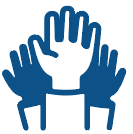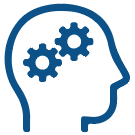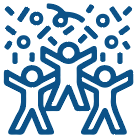Welcome!
Service learning at CSUSB is a high-impact teaching method that promotes student learning through active participation in meaningful and planned service experiences in the community that are substantively related to course content. Through reflective activities, students enhance their understanding of course content, general knowledge, sense of civic responsibility, self-awareness and commitment to the community.
Faculty who teach service learning courses have found that extending the boundaries of the classroom into the community benefits their students' learning in many ways. Students understand and synthesize the subject matter through a broader range of experiences and associations; gain an understanding and appreciation of the community and the diversity of its people; explore an area of study or a career option; critically reflect on personal values and responsibilities as citizens; and gain a belief they can make a difference through their actions. Many students decide to continue their involvement in the community after completing the service learning experience.
The S.E.R.V.E. Model
Service learning is easy to initiate if you understand the underlying concepts and are open to the opportunities it presents. CSUSB follows the S.E.R.V.E model; here are the five steps for effective service learning:
- Select the Service
- Educate and Inform
- Respond to the Need
- Value Significance and Reflect
- Evaluate and Celebrate

Select the Service
Finding a community agency that exhibits a real need for service is a key step for service learning. Ask yourself whether your efforts truly reflect a community-identified need. Be sure to plan your service project based on the needs of the agency, and clarify the steps you will be taking to make sure your project is challenging and engaging to the students and the community.
Getting Started: Finding the Right Community Partner
If you don’t have a community partner, the following tips may help you find one:
- Start early. Allow yourself enough time to develop the right partnership. Give yourself 3 – 4 months.
- Be clear, yet flexible, about what you are looking for in a community partner.
- What do you want students to learn?
- How can students contribute?
- How many students will be participating?
- Why are you interested?
- Network. Talk to other community-engaged faculty in a related field.
- Contact the Office of Community Engaged Learning for support in identifying and connecting with a community partner.
Before You Contact a Potential Partner, Consider:
- Doing your homework. Learn about the community organization online, from colleagues, news sources, and/or your community networks. Email leaveyourpawprint@csusb.edu to find out if the organization is a current CSUSB partner.
- Being clear about what has drawn you to this community partner. Why are you invested in the issue(s) this partner addresses? What experience do you have with the issue, the neighborhood, the people involved with the organization? How could this partnership support your engaged scholarship work?
- Your commitment. What kind of commitment are you willing and able to make to a partner? (E.g. one semester? A year? Many years?) Partnerships of various durations can be effective, but OCEL encourages faculty and community partners to consider longer-term, ongoing partnerships.

Educate and Inform
Become familiar with any training that is involved in your service project. Obtain any information that may be helpful; regarding the site, guidelines and models of service learning, your syllabus, project expenses, the training sessions offered, the individuals being served and the responsibilities involved. Find out how to perform the actual service, the purpose of the service, who and where the students will be performing the service, and any other service-related issues.
Exemplary service-learning syllabi should:
- Include service as an expressed goal
- Clearly describe how the service experience will be measured and what will be measured
- Describe the nature of the service placement and/or project
- Specify the roles and responsibilities of students with the service project, (e.g., transportation, time requirements, etc.)
- Define the need(s) the service placement meets
- Specify how students will be expected to demonstrate what they have learned (journal, papers, presentations)
- Present course assignments that link the service placement and the course content
- Include a description of the reflective process
- Include a description of the expectations for the public dissemination of students’ work
From Heffernan, K. Fundamentals of Service-Learning Course Construction. RI: Campus Compact, 2001, p. 9.
Service learning logistics:
- How will students check in at the site?
- How will students track hours at the site?
- Do students meet with the site supervisor prior to the start of service?
- Are students provided with a work space?
- Will students be asked to bring anything with them?
- Will students be asked to buy anything? If so, will they be reimbursed?
- Will students be working under supervision?
- Will students be working at alternate sites?
- What is required of students prior to starting? Fingerprinting? Background checks? Who pays for this? Who should the site contact in case of emergency?
- Who should the university contact in case of emergency?
- Will students be asked to drive for this placement?
Additional Resources
CSUSB's Guidelines for Service Learning
Consider the Different Models of Service Learning

Respond to the Need
In other words: Action! Follow through on your planning and training, and make sure that your service is making a meaningful impact for everyone involved – both the community and the students. Make sure that this effort is time well spent on making a difference in the world.
Here are some guidelines to make sure your service creates a meaningful impact for the community and for the students. Share with students to make sure they are ready to serve safely!

Value Significance and Reflect
There are numerous ways to actively and personally reflect on the completed service project. Problem solving, journaling, and discussions are only a few, but simply being able to apply the service in a broader perspective is imperative. As you reflect, address and clarify issues related to the service, and attempt to integrate the service learning within the lives of the students. It is important to take time and give all students a chance to think about and discuss the completed service project.
Reflection activities guide students toward discovering, exploring, and evaluating relationships between the course content as they encounter it in readings, lectures, and discussions, and their experiences in the community. Reflection ensures service learning is a dynamic, integrative process that develops students’ knowledge, skills, and judgment.
Need Reflection Ideas?

Evaluate and Celebrate
Evaluation and Celebration of the service are important steps in service learning. Evaluation provides valuable information on the impact of the service effort, the learning that has occurred, and will also provide information about any needed adjustments for the course. Celebrating the service effort will motivate students and increase the chances they will serve again. Find a way to recognize students and be sure the students are given an opportunity to evaluate the project. Some celebration ideas include community events, awards, certificates, reference letters, gifts, or media coverage.
Develop a Service Learning Outcome Measurement Scale
Service learning as a transformative pedagogy has been adopted within Hong Kong’s tertiary education sector for over a decade; however, the lack of a standardized and validated measurement instrument to assess its student learning outcomes has been an obstacle to its further development. The current research study, collaboratively conducted by Lingnan University, The Hong Kong Polytechnic University, Hong Kong Baptist University, and The Education University of Hong Kong, therefore aims to develop such a measurement instrument named the “Service-Learning Outcomes Measurement Scale (S-LOMS),” taking consideration of the unique features of service-learning in Hong Kong.
Service-Learning Outcomes Measurement Scale (S-LOMS)
Document Your Community Engagement Efforts!
Learn about the importance of documenting community engagement efforts in regards to teaching, scholarly work, and service from Dr. Cherstin Lyon.
Documenting Faculty Community Engagement Efforts
Let Us Highlight Your Service Learning Work!
Walk the Walk - A PBS Service Learning Documentary
*Walk the Walk* is a new PBS documentary that focuses on a Social Action course, taught by Scott Myers-Lipton at San Jose State University. What is unique about this service-learning class is that it focuses on changing policy, whether it be on campus or in the community, and it is a model that is easily accessible to teach.
You can view a short trailer of Walk the Walk.
Additional Service Learning Resources
Guides for Teaching Community Engagement and Service Learning Online
Community Engaged Teaching and Reflection